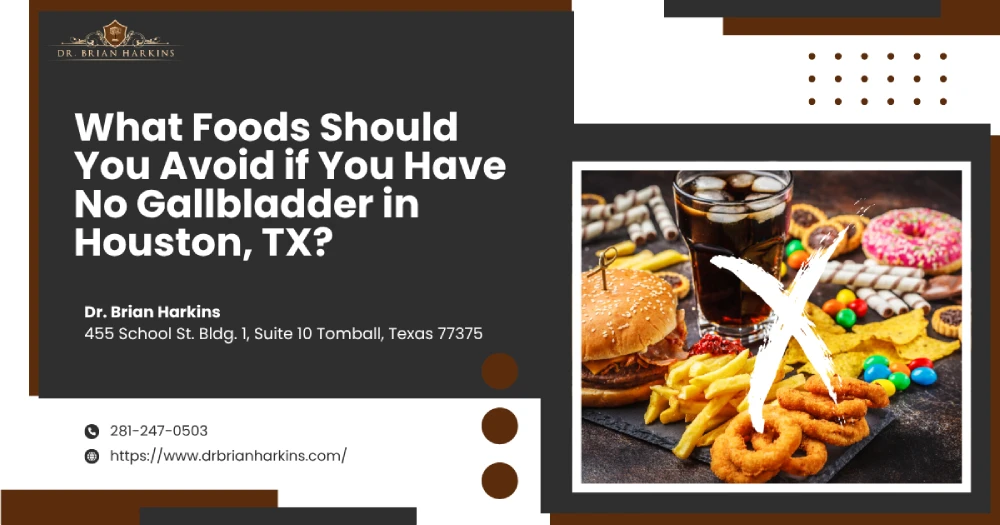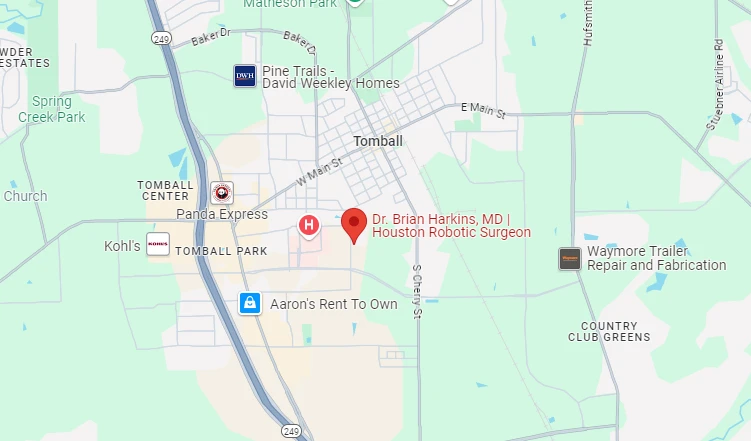
After gallbladder surgery—whether a minimally invasive laparoscopic procedure or a traditional open surgery—the way you digest fat-heavy meals changes dramatically. Your gallbladder was a small, pear-shaped organ that once stored concentrated bile for rapid release. Since your gallbladder has been removed, that storage tank is gone, and you must rethink the foods you eat and avoid. The single best strategy for nipping post-op discomfort in the bud is swapping high-fat, greasy dishes for low-fat foods, whole grains, fruits, and vegetables that ease the flow of bile through your intestine.
Below, you’ll discover a practical “eat and avoid” roadmap for life after gallbladder removal surgery in Houston, plus tips for slowly adding favorite dishes back into your diet, maintaining a healthy weight, and preventing another 2 a.m. gallbladder attack–like pain (known as biliary colic) even without a gallbladder.
So, what foods should you avoid if you have no gallbladder in Houston, TX? Read on for a practical roadmap, local food swaps, and helpful tips to support digestion after gallbladder removal.
Most Houstonians recover in two to six weeks, but digestive surprises can appear days after surgery. Without the gallbladder’s bile “storage purse,” bile trickles 24/7. Large, high-fat meals dilute that bile and leave fat partially digested, which means undigested fat reaches the colon, pulling in water and leading to diarrhea.
About 40 % of patients develop long-term digestive issues if they keep eating a modern Western diet packed with saturated fats and cholesterol-heavy foods. Eliminating or dramatically reducing certain foods can help prevent future problems.
Why they hurt: They exceed the bile’s emulsifying ability, causing greasy stools, bloating, and cramps.
Swap them for skinless turkey sausage, low-fat Greek yogurt, and part-skim mozzarella to keep flavor high and fat low.
Opt instead for a fruit cup dusted with Tajín or a small square of dark chocolate that satisfies without overloading your digestive system.
| Classic Dish | High-Fat Ingredients | Gallbladder-Friendly Swap | Flavor Booster |
|---|---|---|---|
| Queso & Chips | Melted cheese, fried chips | Black-bean dip with baked corn chips | Fresh jalapeño & cilantro |
| Brisket | Fatty point cut | Smoked turkey breast | Hickory smoke, sugar-free BBQ sauce |
| Fajitas | Flour tortillas, sour cream | Corn tortillas, avocado slices | Lime & pico de gallo |
| Crawfish Étouffée | Butter-based roux | Tomato-based stew | Cajun spices minus the roux |
| Chicken-Fried Steak | Deep-fried breading | Grilled sirloin | Peppercorn rub |
Even “safe” foods can cause trouble when eaten in oversized portions. Shifting from three giant meals to multiple mini-meals keeps the fat load low and aligns with the continuous drip of bile.
High-fiber foods like oats, lentils, and apples absorb excess bile. Introduce fiber gradually—too much too soon may cause gas. Drink at least 64 oz of water daily to keep things moving.
Weeks to fully recover vary, but most surgeons recommend waiting at least a few days after surgery before introducing solid foods. Re-introduce healthy fats into your gallbladder diet slowly: avocado, olive oil, and ground flaxseed supply essential fatty acids without overwhelming digestion.
Adopting a popular Mediterranean diet can be useful in helping the gallbladder—or what’s left of the biliary system—stay healthy. Conversely, a modern Western diet stuffed with saturated and trans fats can reignite symptoms.
Dietary tweaks solve most issues, but not all. If you experience yellow stools, night sweats, or sharp pain reminiscent of a gallbladder attack or biliary colic, book an appointment with a Houston gastroenterologist at Texas Medical Center, Baylor St. Luke’s, or Memorial Hermann.
Living without a gallbladder doesn’t mean abandoning Houston’s vibrant food scene. By focusing on low-fat, high-fiber foods, eating smaller portions, and avoiding fried or greasy dishes, you can keep digestion smooth and reduce the chance of painful flare-ups. If discomfort persists, consult a specialist to rule out bile-acid malabsorption or other gallbladder problems. A balanced diet rich in whole grains, fruits, vegetables, and healthy fats will let you savor Houston flavors—minus the pain.
After gallbladder surgery, it’s best to avoid high-fat, fried, and heavily processed foods such as brisket burnt ends, sausage, queso, and creamy sauces. These overwhelm the digestive system and can trigger cramps, bloating, or diarrhea. Choose lean proteins, low-fat dairy, and fiber-rich vegetables instead.
Most surgeons recommend at least four to six weeks of strict low-fat eating while your digestive system adapts. After that, you can slowly test moderate-fat items. Keep saturated fats minimal long-term to help prevent chronic diarrhea or fatty-food intolerance.
Yes. People who have had bariatric procedures already eat smaller portions, which aligns perfectly with post-gallbladder guidelines. Focus on lean protein, high-fiber vegetables, and healthy fats like olive oil, and always chew thoroughly to improve digestion.
Even without a gallbladder, bitter foods—such as arugula, dandelion greens, and lemon water—may stimulate bile flow from the liver. While not a cure-all, incorporating small servings can aid fat digestion and reduce bloating after meals.
High-fat keto plans often trigger diarrhea and discomfort because they exceed your continuous bile supply. A modified low-carb approach with moderate fat and higher fiber is safer. Always consult your gastroenterologist or dietitian before starting keto post-surgery.
Begin with lactose-free or low-fat dairy about one week post-op, starting with yogurt or skim milk. Monitor tolerance before trying harder cheeses or small amounts of butter. If symptoms flare, swap to plant-based alternatives and retry dairy later.
Whole grains like brown rice, quinoa, and oats are usually well tolerated and supply the soluble fiber that binds excess bile. Introduce them cooked and soft to minimize gas. Avoid adding fatty sauces or butter that could offset their benefits.
Persistent upper-right abdominal pain, gas, and diarrhea lasting months after surgery may indicate post-cholecystectomy syndrome. Sometimes small bile duct stones or sphincter spasms are to blame. Seek medical evaluation for imaging and specialized treatment if symptoms linger.
Absolutely. Adequate water dilutes bile salts, helping them move smoothly through the digestive system. Aim for at least eight 8-oz glasses daily, and more if you’re active or live in hot Houston weather.
Yes. The Mediterranean diet’s emphasis on fruits, vegetables, whole grains, legumes, and olive oil suits life after gallbladder removal. Its healthy fats are easier to digest in moderate amounts, and its fiber content stabilizes bile flow, helping keep your digestive system happy.


Dr. Brian Harkins is a renowned surgeon specializing in advanced, minimally invasive, and robotic surgical techniques. With a dedication to innovation and personalized patient care, he has transformed countless lives by delivering exceptional outcomes.

I want a website like this, where do i start?